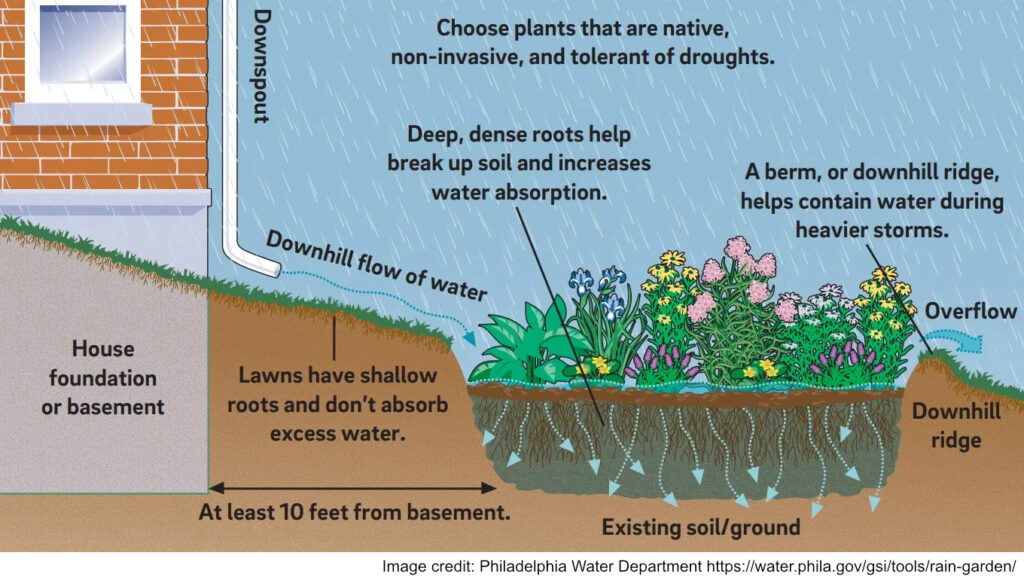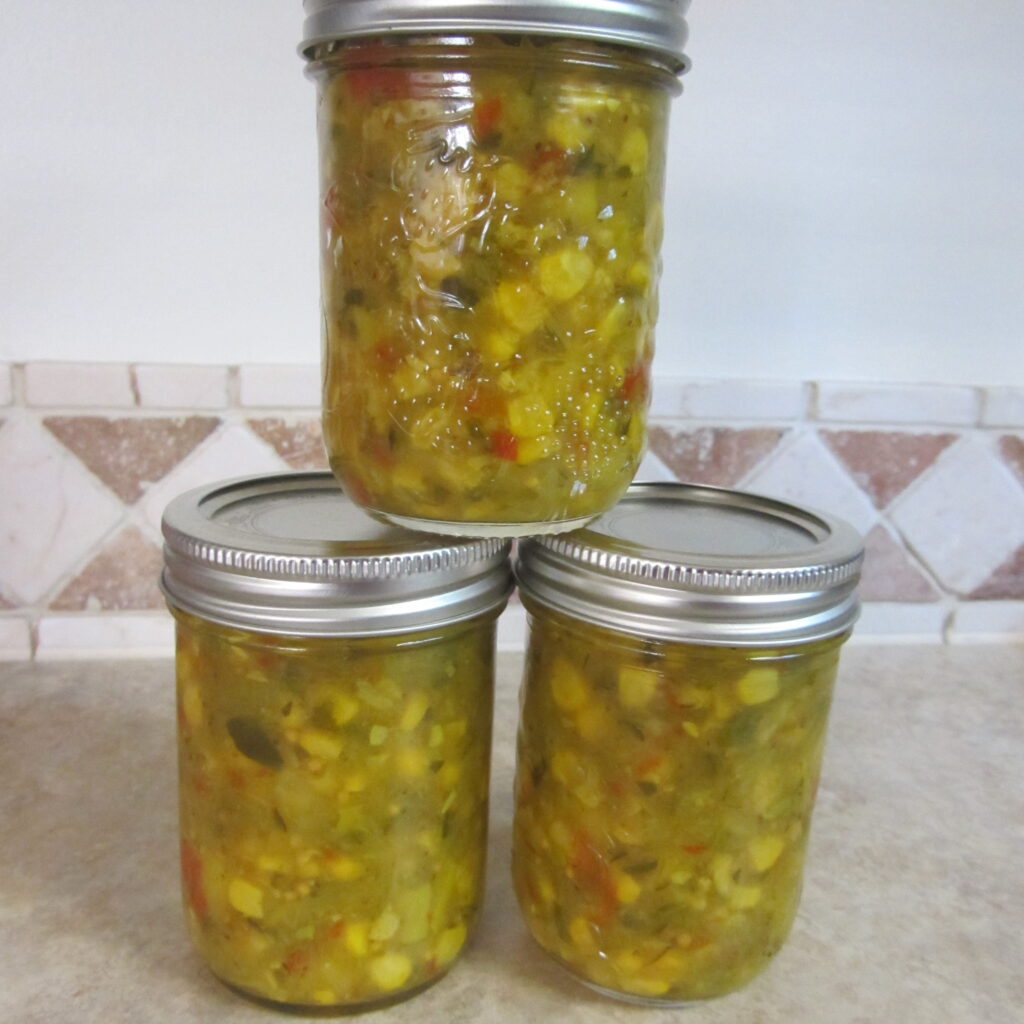
Rain Gardens are a great idea for many reasons. Why not add one to your home garden?
As our climate changes, WATER is increasingly important as a resource. The changing weather patterns worldwide has prompted partial or even complete bans on watering. A regular supply of rainwater is not always available when gardeners need it. More often now, we alternate between huge downpours, and more frequent and longer periods of drought. When the big deluges hit the parched ground, we deal with overflowing storm drains, flooded basements, and additional pollution of streams, rivers, and lakes. This flood/drought trend is predicted to continue in the foreseeable future.
As gardeners, we need to consider this reality when planning our gardens by making the best possible use of available rainwater and choosing our landscaping and planting options carefully. There are a number of things we can do and here’s a quick summary of a few:
- Use more permeable pavers or ground covers in our landscape rather than solid surfaces.
- Choose and grow plants that have the ability to survive with less water.
- Feed and amend our soil so it’s rich in organic materials and retains as much moisture as possible.
- Direct rainwater into rain gardens, barrels, and onto lawns and gardens rather than into storm sewers.
- See the Ontario Horticultural Association’s booklet Roll Out the Barrel, it’a a bit dated but has a lot of useful info.
- OR – install a rain garden!
A rain garden is designed to keep the water where we need it, in our gardens, by capturing rainwater from a roof, driveway, and any other hard surfaces and directing it to a location in our yards where it can soak in. Basically, a rain garden starts with creating a depression in the yard, then adding plants that can handle both dry and wet periods.
Some Basics for Creating a Rain Garden:
1. Choose a site by first seeing where rainwater from the roof typically flows then ensure your chosen site is lower if possible and at least 3m (9′) away from the house foundation to prevent basement moisture.
2. Do an infiltration test to see how fast the rain water soaks into your soil. See below for a link to a video showing how to do this. Check out the size calculator links to figure out how big your garden needs to be.
3. Once you know how big to make the garden. Dig a depression. A depth of 15cm (6″) is sufficient, however, 20cm (8″) is even better as it will allow you to add organic matter and mulch to increase the water retention of your soil. If your property is sloped, use the removed soil to build a berm.
4. Add a shallow channel from your downspout, lay pond liner, then cover it with fist sized river rock with a bit of smaller stone to fill in the spaces. This looks great and slows down the water flow.
5. Choose plants that tolerate both wet feet and dry periods. Native plants are ideal for this garden as are shrubs and small trees. Here are a few of the native plants that like rainwater and can stand drought and many more are listed in the resources linked below.
Perennials
- Bluestar (Amsonia)
- Wild columbine (Aquilegia canadensis)
- Butterfly weed (Asclepias tuberose)
- Swamp milkweed (Asclepias incarnata)
- White turtlehead (Chelone glabra)
- Showy tick-trefoil (Desmodium canadense)
- Spotted Joe-pye weed (Eupatorium maculatum)
- Oxeye sunflower (Heliopsis helianthoides)
- Swamp mallow (Hibiscus moscheutos)
- Cardinal flower (Lobelia cardinalis)
- Wild bergamot (Monarda fistulosa)
- Black-eyed Susan (Rudbeckia hirta)
- Black-eyed Susan (Rudbeckia fulgida)
- New England aster (Symphyotrichum novae-angliae)
Grasses
- Big bluestem (Andropogon gerardii)
- Canada wild rye (Elymus Canadensis)
- Tufted hairgrass (Deschampsia cespitosa)
- Little bluestem (Schizachyrium scoparium)
- Sedges (Carex)
Shrubs
- Red-osier dogwood (Cornus sericea)
- Eastern Ninebark (Physocarpus opulifolius)
- Nannyberry (Viburnum lentago)
- Common elderberry (Sambucus canadensis)
- Winterberry (Ilex verticillata)
5. Place plants close together and mulch well to limit the evaporation of moisture from the soil and discourage weeds.
Properties of a Rain Garden:
- Uses rainfall for your plants rather than letting it run off the property.
- Deeply rooted plants will help reduce erosion on a sloping property.
- Helps reduce the impact on stormwater management systems; keeping local waterways cleaner.
- Provides moisture that supports life of all kinds – including butterflies, birds, and pollinators. A rain garden also doesn’t offer a breeding site for mosquitoes.
- A rain garden is lower maintenance than a lawn and it helps reduce our water bills.
Rain Gardens work. Check out these resources to help you create yours:
Sean James Consulting – an excellent video on how to do an infiltration test
City of London – click on the rain garden arrow
Toronto Region Conservation Authority – A Complete Guide to Building a Rain Garden
University of Minnesota Zone 5 Rain Garden Plants – This is a cooler zone than we are and some of the plants are not native here but it is comprehensive list to get you started
Rain Garden Calculator – this is a good calculator to help you figure out the size needed. Once you know the rate of infiltration, you know the maximum depth you need. You can play with the depth to find a size that suits your space.
Rain Garden Calculator – this uses an average depth of 15cm (6″). It’s an easy way to add your surface area, average rain fall (be sure to over estimate since we are seeing larger rain fall events) and soil type. However, the number of plants and the cost is not a good indication of reality.
City of Guelph – Healthy Landscapes – Rain Garden Plants native to closer to our specific ecoregion.
Updated by: Heather O’Shea – March 2025





About The Author: Armstrong
As an author and editor, Linda directs her lifelong love of nature and plants to concerns about our environment and how we can do better. In addition to decades of gardening experience, and training as a master gardener, Linda focuses on learning from leading science-based educators and writers, and in the process finds that she uncovers many gardening myths.
More posts by Armstrong